Add "Ping" tanks to suspension air bags
Intro:
We run Air Lift auxiliary suspension (air bags) on our truck, 2001 Ford F250. Generally about 70-80#. I grew up with 50's trucks on bias ply tires. Opposed to what most folks like I don't like the more 'compliant' rides of newer trucks. Even our Ford which is known to be a bit more truck like in ride stiffness is soft. Empty I run tires at door sticker + 5#; adjustable shocks little more than half. Also the air bags are great to aid in leveling at camp. Original install of air bag compressor can be seen on Dashair page.My Point is, though I like a tight truck, when the camper is on and the air bags aired to what I'm comfortable with-shocks turned up, it can be bone jarring. In normal hi way its great-our 4000# camper runs straight and stable. In the mountains or tight windy roads no excessive lean and sway. I've front & rear sway bars, increased rear sway bar size, added the air bags & adjustable shocks to maintain ride and control lean & sway. It's a near perfect setup for us.
The problem
As happy as we are generally, it's the top end, say when hitting a pot hole, or just a unusually rough road the suspension dialed in bags cannot compensate and ride becomes harsh.Possible Solution
A recent discussion on RV.net, (link below) the addition of 'ping' tanks got me thinking. I had never heard of this mod/addition to soften the air bag response. Basically folks are adding a small reservoir of air for each air bag. As I perceive -this allows a greater volume of air for compression in relation to the fixed travel of the bag. I have in dash gages for the bags and I can see this. When the camper leans say going around corner or hit a bump the pressure will jump, increase as bags compress. This happens very quickly resulting in the 'bone' jar'. By having more air to compress will allow more suspension travel before hitting max compression. This should alleviate or extend the upper range of suspension before it becomes bone jarring or just harsh. I also see it smoothing out the constant bouncing needles in air pressure gages. What I'm unsure off though is if this will overly soften the ride (like running 40psi instead of 80) but most are saying this isn't the case. I can easily see improving the general ride with this addition, but having a hard time understanding how it's accomplished without losing-desired support.So as it's an easy project, really nothing better to do-might be fun and learn something. Yielding possibly some very good results, and the possibility of improving the ride, decided worth the effort to try. If not happy even easier to restore to previous setup. I have a bag of extra tees & some line. So cost will be minimal. Tanks are free. In the thread mentioned the poster was using small recycled propane tanks. Modified to accept the air lines. Simple & safe purge the cans drill out the valve. Another used old fire extinguisher bottles. Hmmm I've a dozen old dead fire extinguishers.
Forum Thread on Ping Tanks at RV.net
Safety First! Common sense-not sure don't do it. Whatever your using for reservoir insure all pressure is relieved and it's empty. A partially filled can/could be more explosive, and no pressure does not mean its empty! On a propane bottle torch head is good, fully open-turn upside down. On extinguisher bottle-the gages do stick, relieve into garbage can etc. before disassembly. Or buy a new one and show "them" how to effectively use! Note that dry extinguisher powder is corrosive and can make a mess-don't practice on your better half's Caddy :)
I would recommend reading the thread at RV.net for some other prospective and details on modifying the cans. I was going to use the small propane bottles but decided to use fire ext. bottles I have. They're twice the volume, which I don't know if good or bad, but they are aluminum and were a block from the beach so rust is an issue. So this will document modifying my fire extinguishers-then document results. Not a how to or recommendation, just documenting what I did.
So plan is:
- Part 1: Fabricate air reservoir tanks.
(See the RV.net thread for reservoir options)
Part 2: Mount the bottles. Try to make as simple as possible mount for reservoirs on truck
Part 3: Remove air line from bags install tee and run new line to bags & new reservoirs
Reservoir basically doing whatever is needed to adapt tanks to receive air lines. The truck mounts just need to insure tanks can't fall off and are stationary, and as close to air bags as possible.
Plumbing, pretty straight forward, just splice a tee into bag line, run to reservoir. Using push in fitting should be simple, a tee and male adapter at reservoir. However I'm going to install a valve at the bottle. Since this is a test, I want to easily turn reservoirs air on/off. This will allow me to visually, using in cab gages and by ride test and compare ride and results at different pressures with & without reservoirs. On my plumbing, in case this doesn't work to my expectations, the line going to air bag , instead of cutting and splicing in tee, Ill remove air line from bag fitting, run to new tee, then short line to bag. This way will be easy to return as it was (line won't be too short) if not happy.
Part 1
Modifying the fire extinguisher. Well..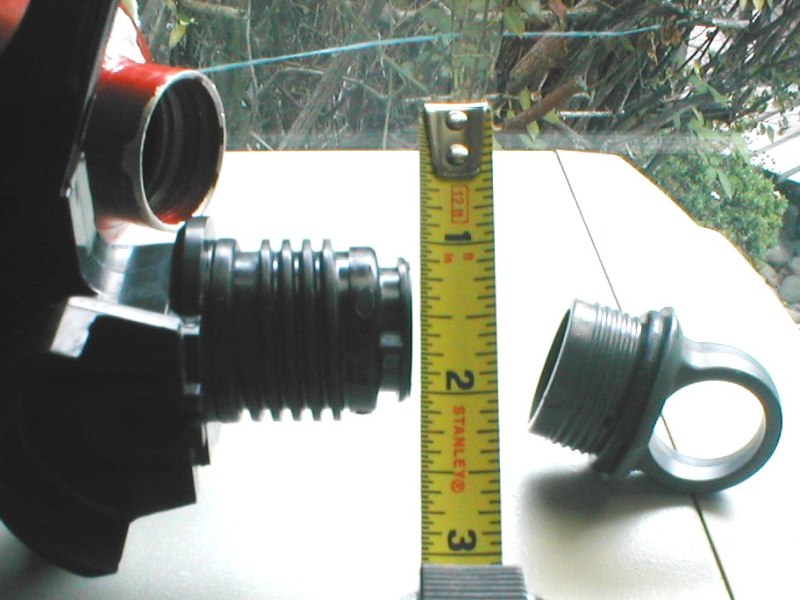
That didn't work....Here I'm showing the thread end of the ext. head. Plan was to remove head, install appropriate bushing into bottle and use a male thread to airline adapter. Obviously I'm not going to find anything handily to match this thread. It's a large semi-acme type bout 9-10 TPI. At the right for comparison, is cap from my alum fuel bottle-it has a more standard machine thread. Have some alum water bottles that have similar but smaller thread. So I gave up on the bottle. My machinist is oversees, but did get a generous offer made to machine an adapter -but don't think this is worth that much effort. So back on the shelf. That was easy...

After a few days playing with a propane bottle it occurred to me that I might be able to cut off all the unnecessary bits from extinguisher head and use it by tapping the body for airline fitting. Huh? Make an adapter from the head with the right odd thread. After looking closely the body is full of slots and holes, any material that isn't required-isn't there, not enough to drill and tap. Hmm gave up again. Then noticed the nozzle-hmmm that ID sure looks close to a 1/4" pipe thread OD. I'm going to try it. Most are using larger line between reservoir and bags. I want to do this spending no money. So I'm going to use 1/4, (as that's all the head will take) it's only about 6-8" length, I have 1/4" stuff. If this works I'll go back and redo with a one piece adapter and possible 3/8" tube.
Removed the gage, activator plunger & nozzle extension. These are held in with small clips, The handles have pressed brass pins so just cut them and mount are off. I cut off extra material from main body, leaving just the nozzle and bottle thread. Shape body with file. The heads plunger hole that activates the extinguisher tapped with 1/4-20 and inserted a brass screw, tapped the gage hole for 10-24, again sealed with brass screw. Cut off bout 1/4 from nozzle to shorten, tapped with 1/4-18 pipe thread. Screwed in the valve. Cool.. You'll note my test valves are brass. I'm using brass inserts and nylon pharaohs so as not to crush or cut airline.
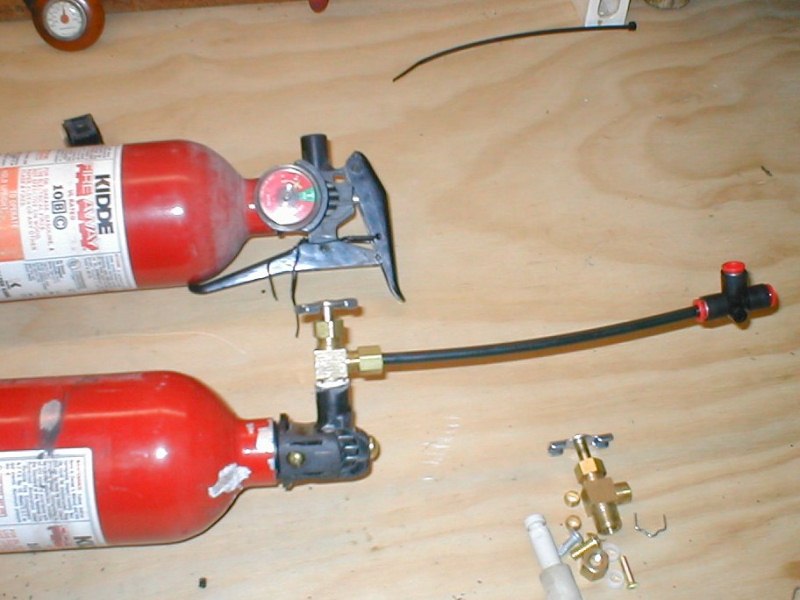
Got it assembled but want to test fit before I actually seal the holes. Check for orientation of valves. Then I'll disassemble an permanently seal the holes in head after making mounts.
The CLIP!
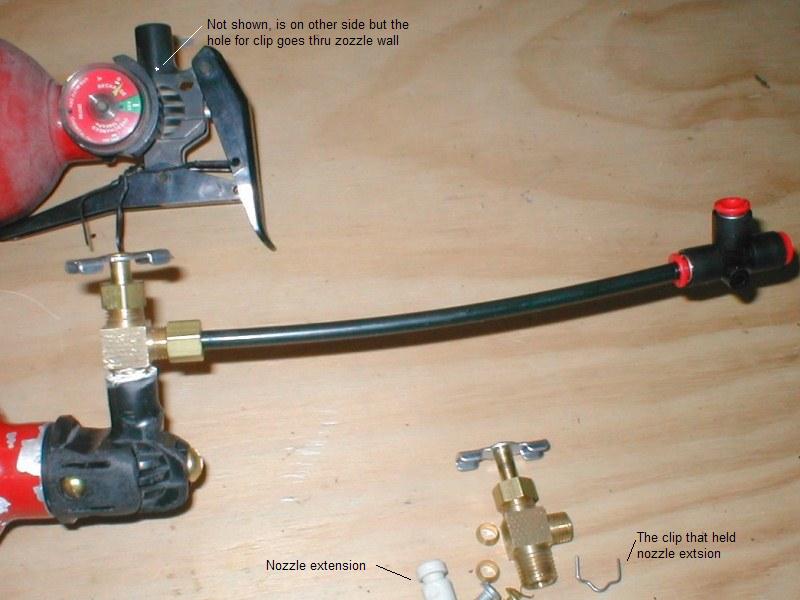
Too late to mount, Just for the heck of it I removed the valve from bottle. Checking for leaks-put my wetted thumb over the base and put a vacuum on head (suck on valveless?. so blowing in it i hear a faint hiss, See that little clip that held in the nozzle extension, the hole on one side where the clip went into penetrates the nozzle. Errrr...simple fix just another screw but though I was done. Didn't think hole penetrated & wasn't open, no light, but either was paper thin or more likely plugged with dirt.
Part 2
Making mounts for ping tanks
To mount, I decided to use some scrap aluminum strip I had. Wrap the bottles; leave a flange bent up that will screw to bed floor to wall lip.
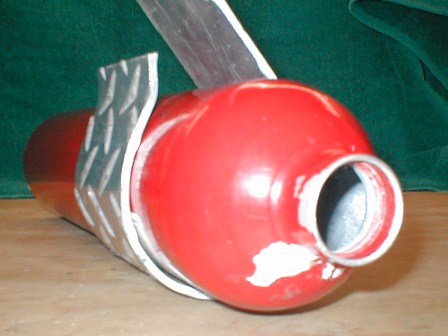
Not shown but I continued the wrap and bent up another lip matching one shown. Leaving about a 1" between to lips. Drilled (3) 3/16" thru both lips. The inner lip will bolt to truck bed flange with 2 screws, screwdriver will access thru outer lip. The center hole will have on long bolt going thru both lips and truck clamping the bottle. Actually worked. I had placed the new mount on bottle centering its weight then held up to trucks flange to mark it. The bottle can only be in one place with neck and valve over fender brace for clearance. So between bottle locations, timing holes to miss spot welds a little tricky. The only real difficulty was drilling up between bed walls. Drill one hole then mounted clamp and drilled remaining holes using clamp as guide.
Part 3
Plumbing, & testing.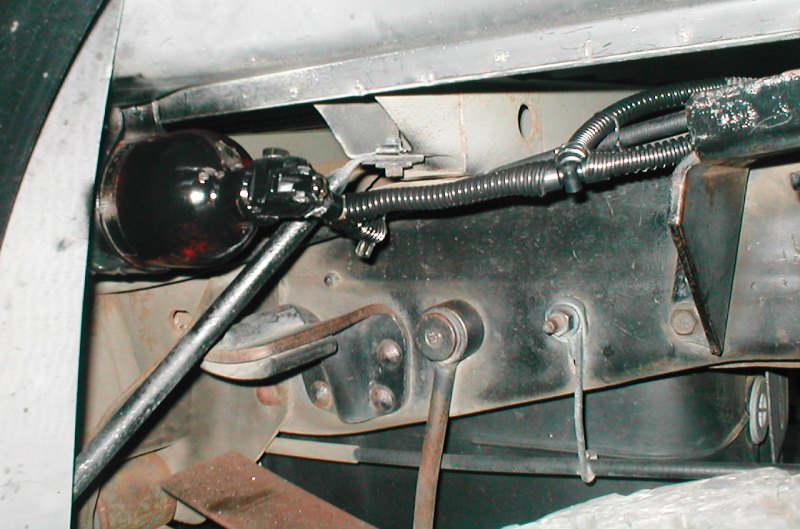
Here drivers side bottle is mounted, its forward of rear wheels. I decided against painting for the moment as I'm going to use some 1/16" poly sheet to make a skirt. It will attach to inside of bed flange but then come back out and attach to back side of well liner. This will keep mud, rocks and cow pies from stalagmite on top of air lines and valves and bottle being struck. I covered the lines with loom, split down, helps the lines but again more to keep dirt packing in the fittings. I needed to go to town but those very red bottles were like neon in the well so quickly dusted them. Think I also want to make a support from tee to flange like ebrake support.
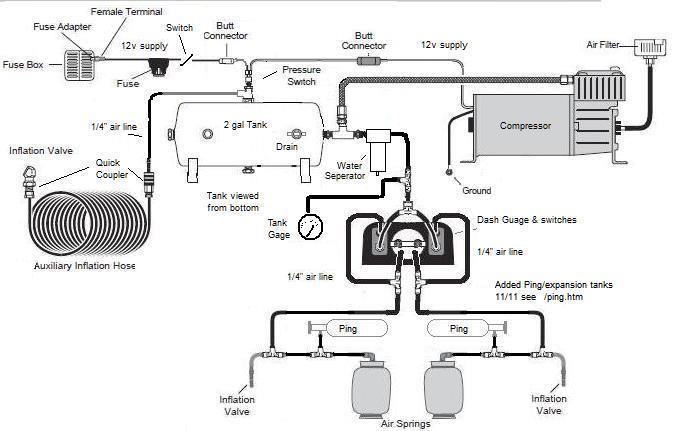
You can see how I plumbed into system, sort of, lines that feed Ping tees actually goes to center of tee and will reach back to bags if needed.
I unplugged line that previously fed bags, trimmed 1/4" and ran to center outlet of a tee. Then I ran short pieces of line to bags and to bottles from tee. This allows easily unplugging main feed (still long enough) and return to bags if any problem with reservoir (ping tanks) or valve.
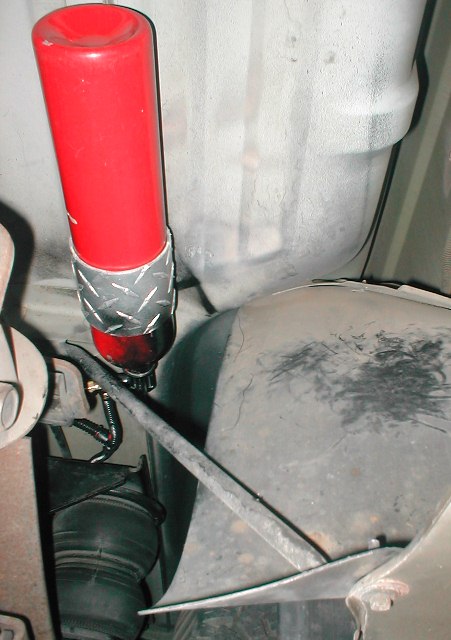
And this is driver side looking up. Once this is all done Ill completely remove do some serious painting and sealing, probably also add a thin strip of plastic (milk carton) between mount and truck.

The passenger was quite a bit harder as the air compressor tank is located in the space where I was accessing the other side. Plus bottle was an inch to long and hitting tank so on this side I bent the clamp flange at an angle in relation to bottle wrap so bottle would set at angle and miss tank. Plus trying to mark & drill holes left handed.
Aired up system to 90#. Closed the valves and drove to town. Fairly rough, gage needles bouncing on in dash gages but not near what I was expecting. (Never driven empty with bags cranked up). I guess because truck is empty harshness and needle movement nothing like with weight of camper. However on return trip home I opened the valves to new reservoirs. Most definitely an improvement, even with truck empty- jar at hitting a bump much less solid and gage needles not reacting! Great!
Eagerly waiting testing with camper on. So I'll be finishing up details in the meantime. I'll leave valves on. As mentioned I can turn off reservoir or if need to, unplug feed airline and return to bags bypassing new plumbing and reservoir bottles. When I get actual camper on results Ill add-but I'm sure this is going to improve the ride quality.
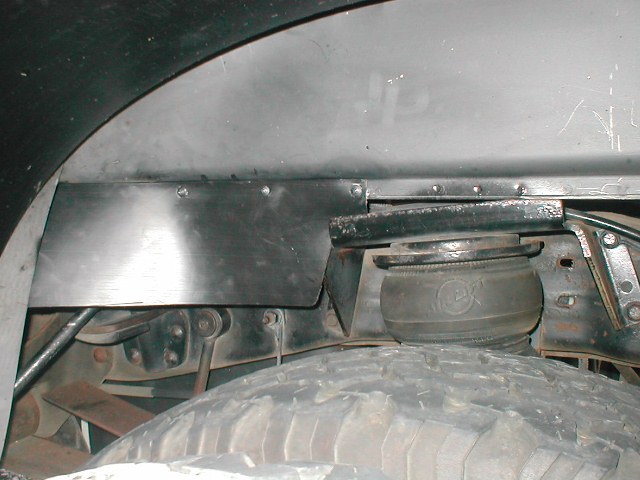
Disassembled everything. Made the skirts with wheel liner plastic to keep mud and cow pies off the tank and line and to protect from rocks etc.
Painted all drilled holes, bolts. Made some insulators to place between al mounts and truck bed, liberally applied anti size to all threaded parts, reassembled lines and reinstalled the tanks. Kinda of a simple project. Surprised I've not heard of this until now.
Loaded camper and test drove-wow. Definitely improves any harshness. But different than I was expecting. I cant quite get how this works. At the one side, hitting say bridge expansion joint etc, hit is absorbed-softer, which makes sense -just more air to compress verse travel of bag. But with no increase in pressure & the more than doubled volume still supports that camper, resisting lean/ I don't quite understand how that works. Watching the in dash gages- the needles do move showing pressure increase but its like watching in slow motion-Just different. Rather puzzling-but bottom line worth the effort.
Back to our F250 truck page
Back to Ourelkhorn Camper Modifications page